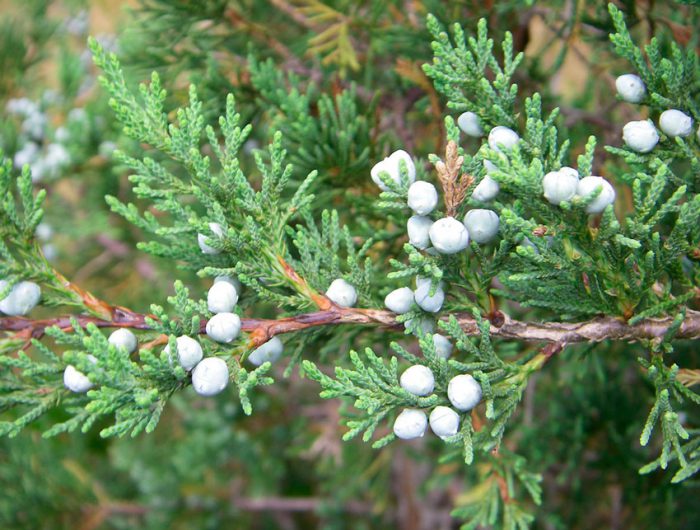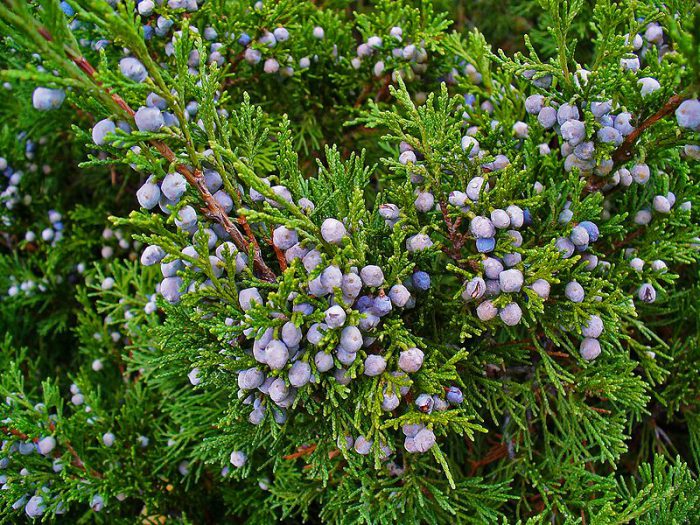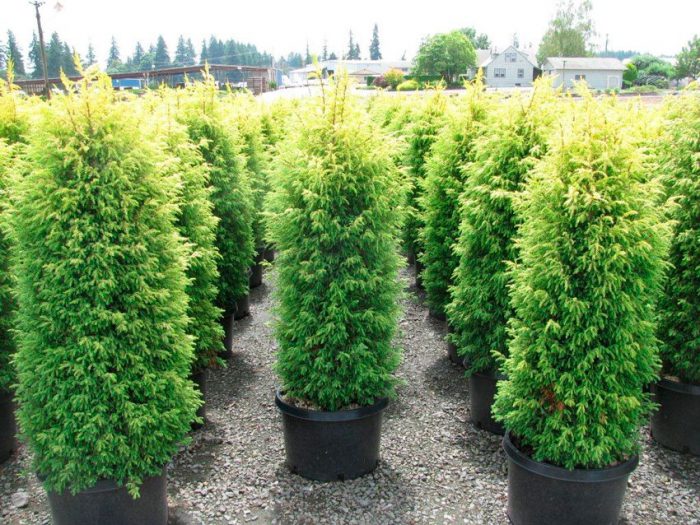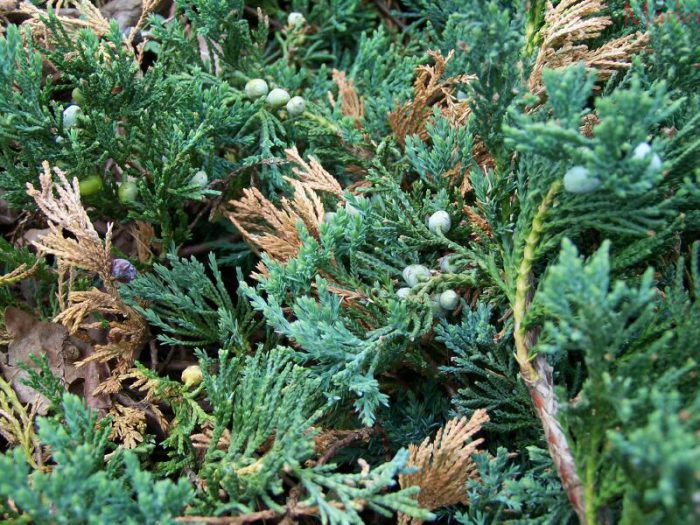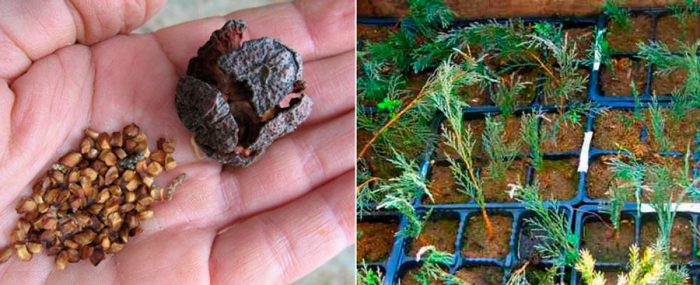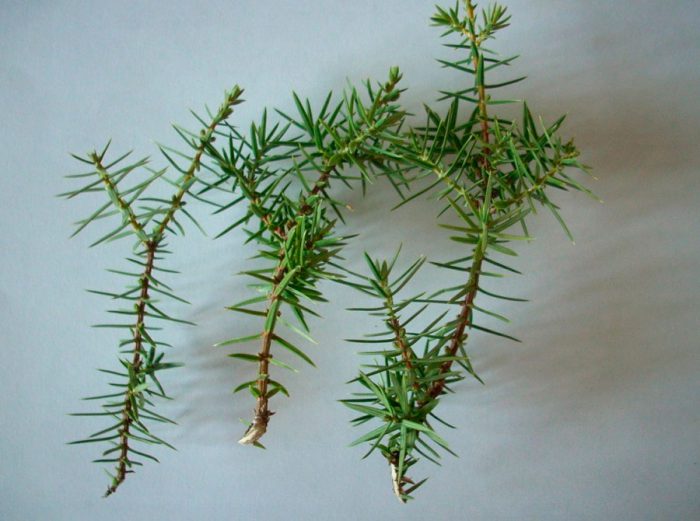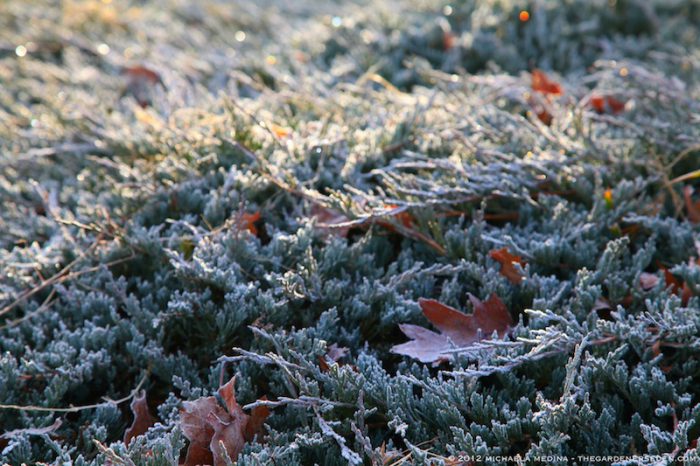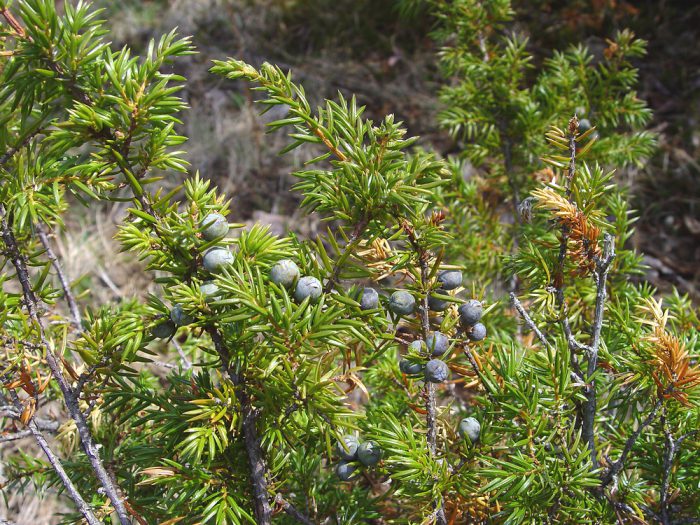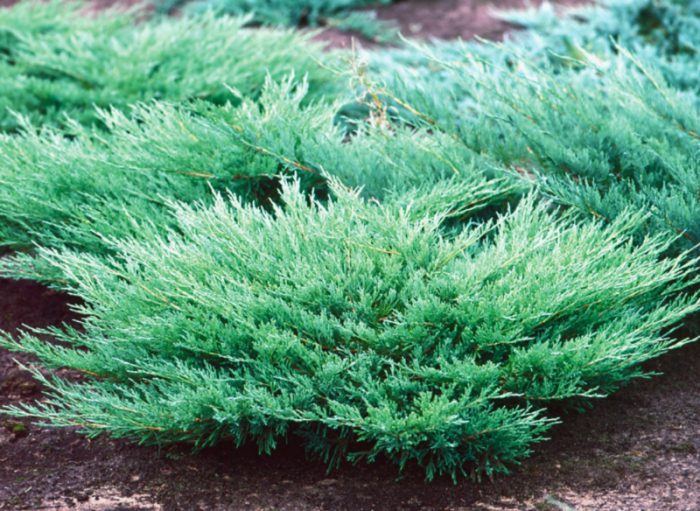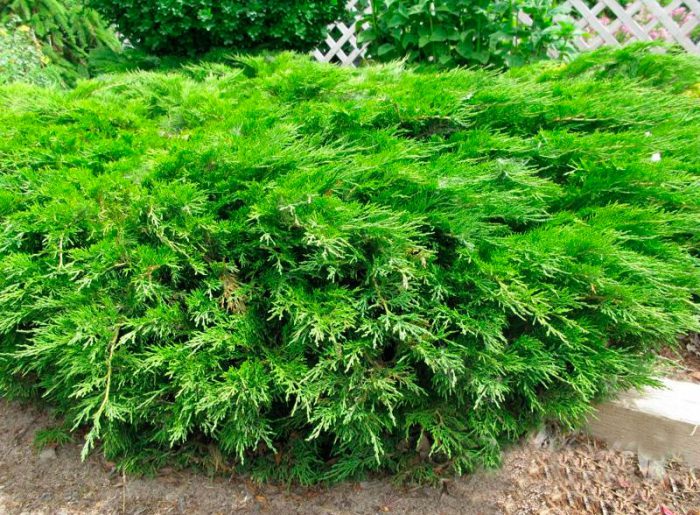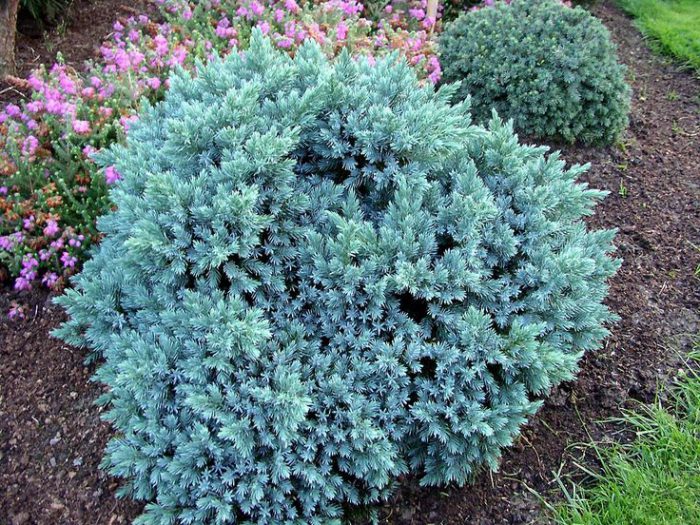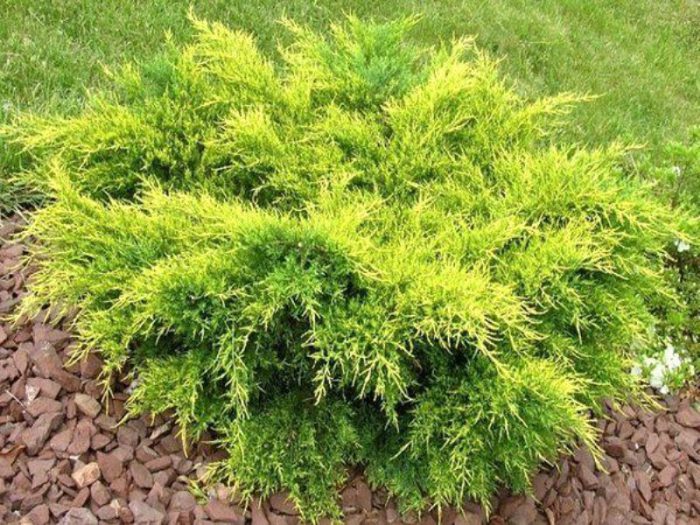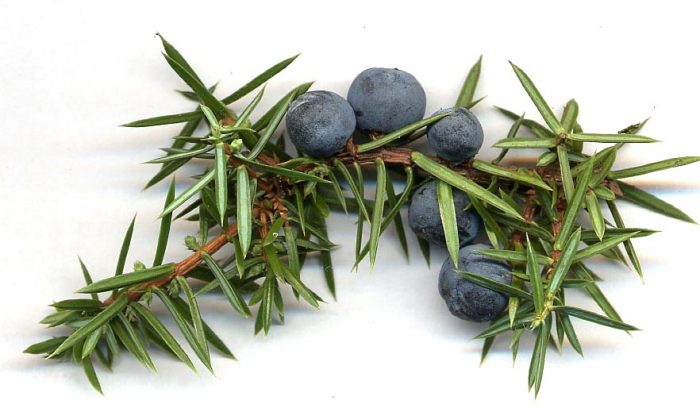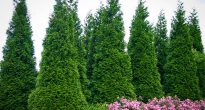A plant like juniper (Juniperus) is also called juniper or heather. It relates to the genus of evergreen coniferous shrubs or trees of the cypress family. In nature, they can be found in the Northern Hemisphere from the Arctic to the subtropical mountain regions. In the classification, the old Latin name of this plant "juniper" was preserved by Karl Linnaeus, it was mentioned in the writings of the poet Virgil, who lived in Ancient Rome. This genus currently unites about 70 species of various plants. Most of the creeping species prefer to grow only in mountainous areas, but the tree belonging to this genus has a height of about 15 meters and is found in the forests of Central Asia and America, as well as in the Mediterranean. Outwardly, this plant is similar to a cypress, and it can live for 600-3 thousand years. In places where juniper grows, the air is incredibly clean. In antiquity, it was believed that juniper is the number one remedy for a snakebite; in Russia it was used to make dishes, in which milk did not turn sour even in the heat. Various remedies for diseases have long been made from the root, cones and essential oils of the plant. Ground juniper fruits are widely used in cooking, as a seasoning for meat dishes, as well as in the preparation of sauces, marinades, soups, pates and liqueurs. The wood of certain types of this plant is used in the manufacture of pencils, canes and various crafts.
Content
- 1 Features of a juniper (shrub)
- 2 Juniper planting
- 3 How to care for the garden
- 4 Reproduction of juniper
- 5 Wintering juniper in the country
- 6 The main types and varieties of junipers with a photo
- 6.1 Common juniper (Juniperus communis)
- 6.2 Juniper virginiana (Juniperus virginiana), or "pencil tree"
- 6.3 Juniper horizontal or prostrate (Juniperus horizontalis)
- 6.4 Juniper Cossack (Juniperus sabina)
- 6.5 Chinese Juniper (Juniperus chinensis)
- 6.6 Rocky juniper (Juniperus scopulorum)
- 6.7 Scaly Juniper (Juniperus squamata)
- 6.8 Juniper medium (Juniperus x media)
- 7 Juniper properties
Features of a juniper (shrub)
Juniper shrub is more popular among gardeners, its height can reach 1-3 meters. But sometimes tree-like forms are found in gardens, the height of such a plant is 4–8 meters, but in some cases it is about 12 meters.The erect stem is branched. In young specimens, the bark is brownish-red, while in the old plant it is brown. Needle-shaped or scale-like leaves are collected in whorls in several pieces. Such a shrub is dioecious. Female oval cones, fragrant with a pleasant spicy taste, reach 0.5-0.9 centimeters in diameter, they are colored green. Male cones are similar to elongated oval-shaped spikelets, which have a rich yellow color and are located in the leaf sinuses. Ripening of these cones takes place in the second year. Inside they have a dozen seeds, while on the surface there are tightly closed fleshy scales.
Many different types of such a plant are cultivated, while it is grown both outdoors and in the house. For example, juniper bonsai are very popular.
Juniper planting
What time to plant
It is recommended to plant a seedling in the garden in springtime (April or May). And such a shrub can be planted in the autumn (October). This plant is very fond of light, but the common juniper can grow in a slightly shaded place. There are no special requirements for the soil. However, it is recommended for him to choose loose, moist, limestone or sandy soil. The acidity of the soil should be within the pH range of 4.5–7 (depending on the type and variety of juniper).
Juniper seedlings
Saplings that are 3-4 years old are suitable for planting in the garden. It is recommended to buy them in garden centers or nurseries that have proven themselves well. In the case when the seedling is in a container, the volume of which is from 3 to 5 liters, then it takes root well and begins to grow quickly. If you use rather large seedlings, then some experience will be needed to plant them, and they will take root much more slowly. Inspect the seedling carefully before purchasing. If there are any signs of illness, then it is better not to acquire such a copy. When planting a plant, try to keep the clod of earth on its roots intact. The fact is that if the soil crumbles, it will lead to injury to the tips of the roots, as a result, the seedling will be sick for a long time and, as a result, can die. If the seedling is planted in a container, then it can be planted in the garden at any time during the season, but it is better to exclude hot days. Before planting a plant, its root system must be immersed in water for a couple of hours. Young seedlings with open roots are recommended to be planted in spring time or in the last summer days in wet weather. If desired, the roots of the shrub can be treated with an agent that stimulates root growth (Kornevin) just before planting.
How to plant
If the plant grows large enough, then leave 150-200 centimeters between the bushes. If the bushes are compact, then the distance between them should be about 50 centimeters. The depth of the hole directly depends on the size of the seedling's clod of earth, while its size should exceed the root system by 2 or 3 times. If the seedling is not very large, then a hole of 50x50x50 centimeters is enough for it. Half a month before landing, a layer of broken brick and sand should be laid out at the bottom of the landing hole for drainage, while its height should be from 15 to 20 centimeters. After that, 2/3 the hole is filled with a mixture of nutrients, consisting of sand, soddy clay soil and peat (1: 1: 2), into which 200 to 300 grams of nitroammophos should be poured and everything is mixed well. If you are planting Verginsky juniper, then add ½ part of a compost bucket to the soil. Moreover, if it is planted in poor sandy soil, then you also need to pour in half a bucket of clay. When planting Cossack juniper, 200 to 300 grams of dolomite flour should be added to the soil. After half a month, the soil will settle and a seedling must be planted.A seedling should be placed in the hole and filled with a soil mixture of a similar composition, but without fertilization. After planting a large seedling, its root collar should rise 5-10 centimeters above the ground level. In the case when the plant is not very large, after planting its root collar should be flush with the soil surface. The planted juniper must be watered, and when the liquid is absorbed, you need to cover the surface of the trunk circle with a layer of mulch (sawdust, peat or chips), its thickness should be from 5 to 8 centimeters.
How to care for the garden
Growing
Growing a juniper is easy enough. During the season, watering should be done only in prolonged heat, while 1–2 buckets of water are taken for 1 adult specimen. Juniper reacts favorably to foliage moisturizing, which is recommended to be done once a week, especially this procedure is required for Chinese and common junipers. Periodically, the soil surface of the trunk circle should be loosened and at the same time it is necessary to pull out the weeds. It is recommended to feed the juniper in spring, for this, 30 to 40 grams of nitroammofoska must be distributed over the surface of the trunk circle. Fertilizer is embedded in the soil, and then watered. In the event that the plant is planted in very poor soil, then it should be fertilized in this way throughout the growing season, but the break in feeding should be at least 4 weeks.
Pruning
Juniper pruning is usually done when they want to make a hedge out of this shrub. Otherwise, trimming should not be performed. However, in the event that you want to form a bush, you must be extremely careful. The fact is that if you cut off something extra, then it will take a very long time to recover, since this is a slow-growing plant. Experienced experts recommend sanitary and thinning pruning, and you can also trim branches that are too long or look sloppy.
Transplant features
It happens that an already mature plant needs to be transplanted to another place. It should be remembered that for an adult plant, a transplant is a great stress, and even more so for a juniper. Is it possible to transplant a shrub so as to harm it as little as possible? How exactly to prepare a planting hole for a given plant, and what size it should be, is discussed above. The bush itself must also be prepared for transplantation. In spring, you need to retreat from the trunk or bush from 30 to 40 centimeters, then take a sharp shovel and use it to cut the soil to the depth of the bayonet. This way you can separate the peripheral young roots from the juniper root system. Then you need to wait until the onset of the autumn or next spring period. During this time, young roots will have time to grow inside the clod of earth, which was cut off. As a result, the plant can be transplanted almost painlessly.
Harmful insects and diseases
Often this shrub is affected by a fungal disease such as rust. In an infected bush, spindle-shaped thickenings appear on the shoots, cones, needles and skeletal branches. At the root collar, swelling and sagging appear, while on their surface the bark dries, crumbles, as a result, not very deep wounds are exposed. Infected branches dry up and die, while the needles turn brown and fall off. In the event that the plant is not treated, then it will die. In order to prevent this, as soon as the disease is noticed, it is necessary to cut off the infected branches, while the wounds and cuts are disinfected with a solution of copper sulfate (1%), and after that they must be smeared with garden varnish or Ranet paste. Those branches that have been cut must be destroyed. For prophylactic purposes, it is recommended to spray juniper in spring and autumn with a Bordeaux mixture (1%) or a similar action.Also, the shrub can suffer from alternaria, shute, nectriosis of the bark of branches, biotorella cancer and drying out of branches. All of these diseases can be cured in the same way as rust. It must be remembered that if you take good care of the bush, then it will not become infected with any diseases and pests.
Such harmful insects can settle on a juniper, such as:
- Miner moth. You can get rid of it with Decis solution (2.5 grams of substance per bucket of water). Processing should be carried out 2 times with a break of half a month.
- Aphid. In this case, the treatment should be carried out also 2 times with a break of 2 weeks with Fitoverm solution (for 1 bucket of water, 2 grams of substance).
- Spider mite. The infected plant must be treated with a Karate solution (50 grams of substance for 1 bucket of water).
- Shields. For destruction, you should use a solution of Karbofos (for 1 bucket of water 70 grams).
Features of growing in Moscow
Cultivation of juniper in Moscow and the Moscow region, where the climate is cool enough, is no different. This plant tolerates wintering well, however, young plants are still recommended to be covered with spruce branches for the winter.
Reproduction of juniper
How can you multiply
Seedlings of this plant can be purchased quite easily, and therefore there is no particular need to use various methods of reproduction of a juniper. But if you still want to grow a juniper with your own hands, then you need to remember that creeping forms can be propagated by layering, and woody and bush forms can be propagated by green cuttings and seeds.
Reproduction of juniper by seeds
Before sowing the seeds of a given plant, they need to be prepared. To do this, they must be stratified, and this requires cold. Seeds must be sown in a box filled with earth mixture, then this container is taken out into the street and placed under a snowdrift. The seeds should stay there for 4–5 months. The prepared seeds are sown in open ground in May. If desired, in May, you can sow unprepared seeds, but in this case you need to know that the first shoots will appear only next year. In some species of such a plant, the seeds have a rather dense shell in connection with this, before they are planted, they must be scarified. So, to accelerate germination, the seeds are exposed to acid or the shell is mechanically damaged. So, the most often used method is when the seeds are placed between two boards, upholstered with sandpaper from the inside. Then they must be rubbed. After the seeds are stratified, they are sown into the ground, while the planting depth should be from 2 to 3 centimeters. It is quite easy to care for the sown seeds. It is necessary to sprinkle the surface of the bed with a layer of mulch, water if necessary, during the first 14 days you need to protect the bed from direct sunlight. You should also systematically loosen the surface of the beds and pull out weeds. At the age of three, it will be possible to transplant a seedling to a permanent place, transferring it along with an earthen lump.
Reproduction of juniper cuttings
Decorative forms do not propagate by seeds; cuttings are used for this. They should be prepared in the spring, while cuttings are cut from young shoots that have become lignified. The length of the cutting should be from 5 to 7 centimeters, while it must have 1 or 2 internodes, as well as a heel. To do this, the stalk should not be cut, but it is torn off by hand so that a piece of bark from the parent plant remains at its end. Immediately, the cutting should be treated with a root growth stimulating agent. Then the prepared material for planting is planted according to the 7x7 scheme in an earth mixture consisting of sand and peat (humus), taken in a ratio of 1: 1, while the surface must be sprinkled with coarse sand (layer thickness from 3 to 4 centimeters). After planting, each cutting separately must be covered with a glass jar.It is necessary to deepen the cutting by 15–20 mm; therefore, rooting will take place in the sandy layer. By the onset of the autumn period, the cuttings will take root, but transplantation to a permanent place can only be carried out after 2 years.
Reproduction by layering
If the juniper is creeping, then layering can be used for its propagation. At the same time, the plant can be propagated in this way during the entire period of active growth. For layering, you need to choose young, barely ripe branches, since they very quickly give roots. First you need to loosen the surface of the soil around the plant, mix it with loose peat and river sand, and then moisten it. To a height of 20 centimeters from the base, the layers must be freed from the needles, then this part should be bent to the soil surface and fixed with pins. After 6-12 months, the cuttings will give roots, but during this time it should be watered systematically, and also spud. After young shoots grow on the layer, they will need to be disconnected from the parent plant and planted in a permanent place.
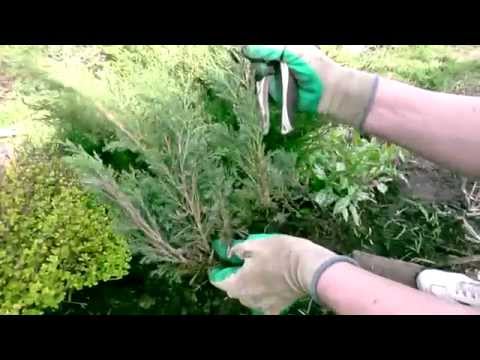

Watch this video on YouTube
Wintering juniper in the country
Fall
In autumn, this plant must be prepared for wintering. For this, the juniper is pruned for sanitary purposes, while the injured, dried out and growing branches and shoots are cut off. Then the plant and the surface of the trunk circle are treated with a solution of Bordeaux liquid (1%) in order to prevent various diseases and harmful insects.
Winter
Juniper is frost resistant. In areas with mild winters, you do not need to cover it for the winter, but you should pull off the branches with twine. It is recommended to cover young plants for the winter with spruce branches.
The main types and varieties of junipers with a photo
In landscape design, juniper is very popular, so experts are trying to develop new, more interesting varieties and forms. Many natural species are also grown quite successfully by gardeners in their garden plots. Below will be presented the most popular species, varieties and forms of this plant, as well as their brief description.
Common juniper (Juniperus communis)
This is a shrub or tree, the height of which can vary from 5 to 10 meters. The trunk reaches 20 centimeters in diameter. The tree has a dense cone-shaped crown, and the shrub is ovoid. The fibrous bark is colored brownish-gray, while the shoots are brownish-red. The green, pointed, needle-like needles are triangular. The length of the needles can reach 15 mm, and they stay on the branches for 4 years. Blooming is observed in May. The female flowers are green and the male flowers are yellow. The life span of this plant is about 200 years. Cones are round in shape in diameter up to 10 mm, while immature they have a green color, and mature ones - bluish-black, there is a coating of wax on their surface. Varieties of this plant:
- Depressive (pinned) - this creeping wide-flat form can reach a height of 100 centimeters. Her needles are not as long and thin as in the main species.
- Montana - such a creeping form reaches a height of 20 centimeters. The triangular branches are thick and short.
- Green Carpet - This dwarf creeping shrub has a flat crown. Its soft needles are pale green. For 10 years, the plant is able to grow only 10 centimeters in height. In this case, the crown in diameter can reach 150 centimeters.
- Columnaris Is a columnar shape. The plant has a blunt top, it reaches 150 centimeters in height and 30 centimeters in width. On the ascending shoots there is a short needles, at the bottom it is greenish-blue, and at the top it has a whitish-blue strip.
There are also a very large number of varieties and forms of this species, for example: Horstmann, Erekta, Nana Aurea, Meyer, Pyramidalis, Repanda, Sentinel, etc.
Juniper virginiana (Juniperus virginiana), or "pencil tree"
Such an evergreen tree can reach a height of about 30 meters. In young specimens, the crown has a narrow ovoid shape, then gradually it becomes prostrate due to widely spaced branches. The trunk can be up to 1.5 meters in diameter. The peeling bark is colored brown-red or dark brown, and in young shoots - green. Small, scaly or needle-shaped needles have a dark green color. In diameter, the spherical berries can reach 0.6 centimeters, they have a dark blue color and a bluish bloom. Cultivated since 1664
The most popular with this species is such a cultivar as Blue Arrow. It has several forms: pin-shaped, columnar and shrub. Among them are Gray Oul, Glauka and Boskop Purple, which have blue needles, Robusta Green and Festigiata - greenish-blue needles, Canaertia - dark green needles, Silver Sprider - greenish-silver needles.
Juniper horizontal or prostrate (Juniperus horizontalis)
Under natural conditions, this plant can be found in Canada and the United States. It prefers to grow in the mountains, on the sandy coasts of rivers and lakes, as well as on the hillsides. This creeping form can reach a height of about 100 centimeters. It has long branches with densely spaced tetrahedral shoots, colored greenish-blue. The needles can be green or blue, but in winter they have a brownish tint. In diameter, the fruits can reach 0.9 centimeters, they have a black-blue color and a light blue bloom. This species has been cultivated since 1840.The most popular forms are:
- Andorra Compact - this cultivar can reach a height of 30 to 40 centimeters. The crown is about 100 centimeters in diameter and has a pillow-like shape. The branches go up obliquely. Small, scaly needles are colored greenish-gray, but in winter they turn purple.
- Plumosa (Andorra Jupiter) - in height, such a creeping shrub can reach up to half a meter, and in width - about 2.5 meters. Branches lie on the surface of the ground. On the feathery branches are subulate needles. The needles are light greenish-gray in color, but in winter they take on a purple hue.
- Prince of Wales - the height of this creeping shrub can reach 30 centimeters, while the crown has a diameter of up to 250 centimeters. The bark is brown in color. Dense blue needles in winter acquire a light red hue.
Juniper Cossack (Juniperus sabina)
In height, this creeping shrub can reach 150 centimeters. It grows rather quickly in width, as a result of which dense thickets are formed. Less often, you can meet tree-like forms, their curved trunks can reach a height of 4 meters. This species has 2 types of greenish-blue needles, namely: in young specimens - acicular, in adults - scaly. Such a shrub has a characteristic feature, if you grind its needles or a shoot, then you can feel a pungent smell. This is due to the fact that the plant contains sabinol (poisonous essential oil). It has been cultivated since 1584. The most popular forms:
- Capressifolia - in height, this undersized shrub can reach half a meter. It has a wide crown. The shoots are open, move away from the base of the plant and rise up. Scaly needles are bluish-green in color. At the bottom of the crown, needle-like needles sometimes come across.
- Femina - this shrub reaches a height of 150 centimeters, and its crown has a diameter of about 500 centimeters. The color of the bark is brown-red, while on the shoots it is dark green. Scaly needles smell unpleasant and are poisonous, painted in a dark green color.
- Mac - a bush in height can reach from 150 to 200 centimeters, while the crown has a diameter of about 8 meters. The color of the bark is grayish red. In the lower part of the crown, needle-like pointed needles are green, and in the upper part, they are gray.
Chinese Juniper (Juniperus chinensis)
This is a tree with a pyramidal crown, which reaches a height of 8 to 10 meters. However, sometimes there is a bush pressed to the ground or spread out. The peeling bark is grayish-red, and the shoots are dark green. The foliage is scaly, but at the bottom of the crown or in young specimens there are thorny needle needles. Popular varieties:
- Strickta - a narrow-gored plant branches strongly. The branches are evenly spaced and raised. Straight shoots are short enough. The needles are needle-like, in the upper part it has a bluish-green color, and in the lower part - as if covered with frost. In winter, the needles turn yellow-gray.
- Olympia Is a narrow-columnar form. The branches are raised, the branches are short. There are 2 types of needles: scaly light blue and needle-like bluish green.
- Japonica - a dwarf form, it is found creeping, as well as pin-shaped, reaching a height of 200 centimeters. The short branches are quite dense. The spiny, scaly, sharp foliage is pale green.
- Gold Coast - in height such a shrub can reach 100 centimeters, while the diameter of the crown is 300 centimeters. The needles are yellowish-golden, they become darker after the fall.
Rocky juniper (Juniperus scopulorum)
The homeland of such a plant is North America. The species is represented by a shrub or tree, which reaches a height of 18 meters. The crown begins almost from the base and has a spherical shape. Young shoots are 15 mm thick, they are painted in pale green or bluish green. In most cases, there are scaly needles, but there are also needle-shaped leaves. On the surface of the dark blue fruit there is a bluish bloom. Popular varieties:
- Repens Is a creeping shrub. On low-lying branches there are feather-like branches that rush up. The length of the needle-like leaves is about 0.5 centimeters, they are blue at the top, and bluish-green at the bottom.
- Springbank - the height of such a narrow-gleaming juniper is about 200 centimeters. Its upper branches are flexible and spaced apart from each other, and the tips of the shoots are almost threadlike. Scaly needles are bluish-silvery in color.
- Skyrocket - Dutch tall cultivar with a narrow habit. When the plant reaches 3 years old, its height will be 10 meters. There are straight shoots and greenish-gray needles.
Scaly Juniper (Juniperus squamata)
This species is quite variable, and it is represented by an evergreen shrub, which can reach a height of 150 centimeters. The color of the bark is dark brown. Tough, sharp, lanceolate needles are colored dark green below, and on top they have a whitish tint due to stomatal stripes. Fruit color is black. Cultivated since 1824 Popular varieties:
- Blue Star - the dwarf Dutch cultivar reaches a height of 100 centimeters. The diameter of the dense semicircular crown is about 200 centimeters. The needles are whitish-blue, they look most beautiful in the late spring and early summer period.
- Meyeri - a decorative form of a shrub. While the plant is young, it branches strongly, and the height of an adult specimen varies from 2 to 5 meters. The needles are very beautiful bluish-white.
- Rodery - an upright shrub has a kegle-like dense shape. Its height is about 150 centimeters. Needle short leaves are quite sharp, they are blue above, and green below.
Juniper medium (Juniperus x media)
This hybrid is the result of crossing the Chinese and Cossack junipers. This shrub has arched shoots with drooping ends. There are two types of needles: inside the crown it is needle-like, and the rest is scale-like.During growth, it has a pale green color, but darkens over time. The height of adult plants is 300 centimeters, while the width is 500 centimeters.
The most popular variety is Mint Julep. It is a sprawling shrub that grows quickly. The shape of the crown is wavy. At the age of ten, the plant is 150 centimeters tall and 300 centimeters wide. Since the size of the shrub is large enough, it is often planted in large gardens and parks.
Also cultivated are such species as: Daurian, recumbent or inclined, false Cossack, oblong, Sargent, Siberian, hard, Turkestan. And also other types of varieties and shapes.


Watch this video on YouTube
Juniper properties
Healing properties
For a long time, this plant has been considered a cure for any disease. Young shoots and roots are considered medicinal, but cones are often used for treatment. The roots will help to heal tuberculosis, bronchitis, skin diseases, stomach ulcers. The plant relieves toothache, swelling, normalizes heart function, removes inflammation in the lung and bronchial tissue, normalizes blood pressure and blood circulation, eliminates constipation. Diathesis is treated with a decoction of the branches. The needles have a powerful antibacterial effect, which is stronger than that of other plants. The composition of the fruit includes carbohydrates, wax, sugars, coloring and tannins, organic acids, vitamins, iron, manganese, copper, aluminum and essential oil, which has a choleretic, antimicrobial, diuretic and expectorant effect. Compresses are made from the decoction of the fruit on sore joints, and it is added to the bath for rheumatism and gout. Taken orally, the decoction helps to improve appetite and digestive processes, enhance the secretion of bile and improve intestinal motility.
Fruit decoction recipe: crush 1 large spoonful of fruit and add them to 200 grams of freshly boiled water. Let it simmer for 10 minutes. The broth should be infused for 30 minutes, strain.
Contraindications
Juniper products should not be taken during pregnancy, severe hypertension, acute inflammation of the kidneys and individual intolerance.

